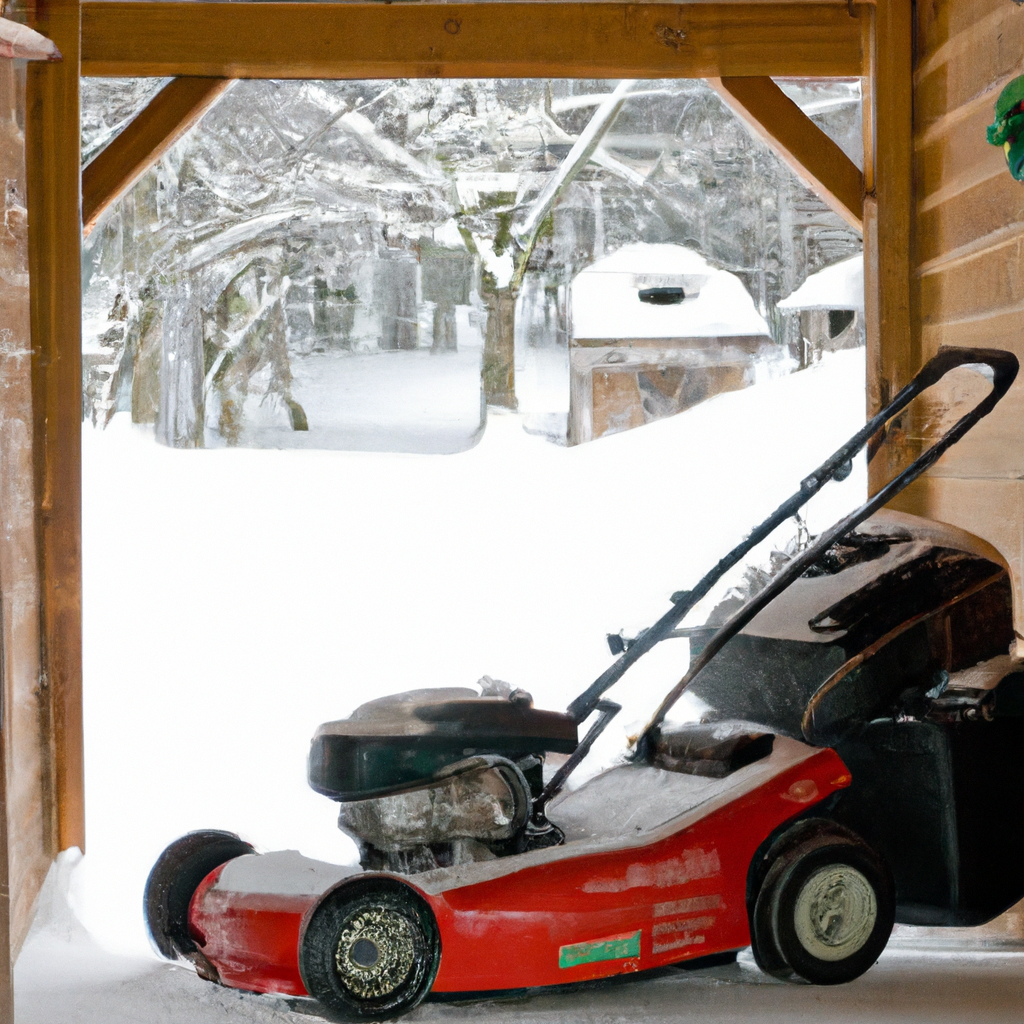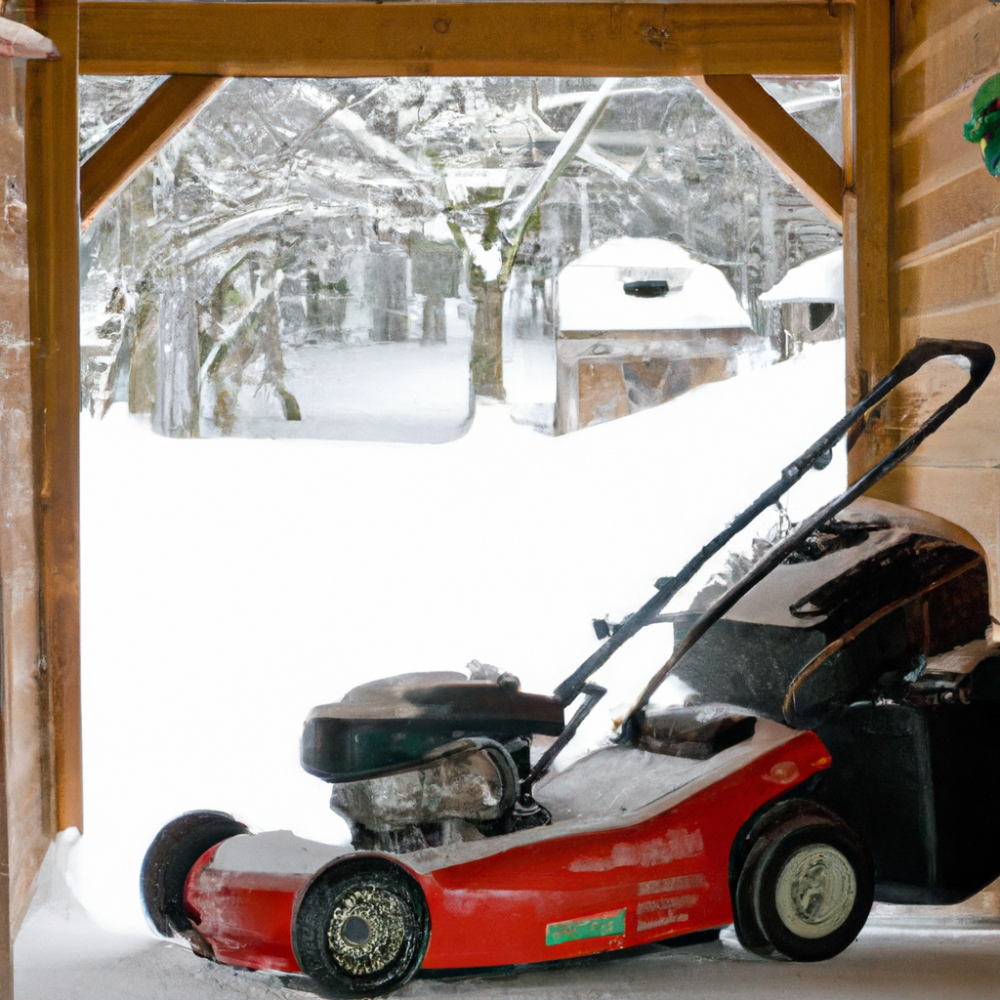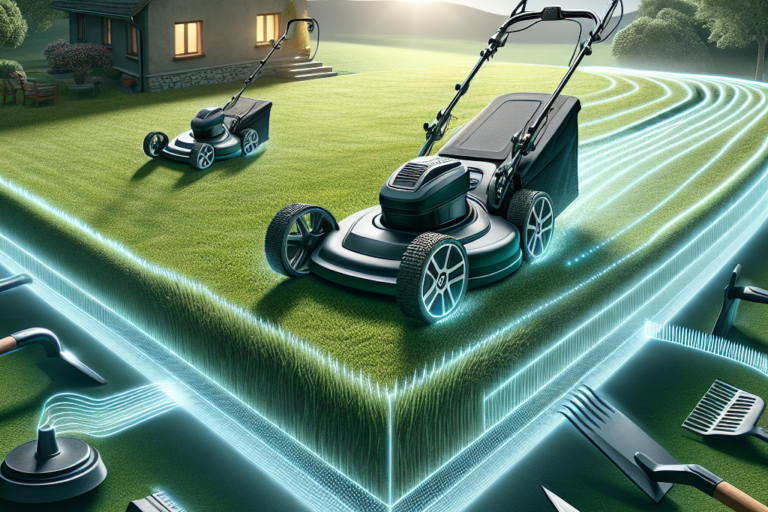As the chill of winter sets in, you may find yourself wondering what to do with your trusty electric lawn mower. Will it survive the cold temperatures and be ready to mow come spring? Fear not, for in this article, you’ll discover whether electric lawn mowers are suitable for winter storage. Find out how to properly prepare and store your mower, ensuring its longevity and performance when the grass begins to grow again. So, bid adieu to any worries about your outdoor companion during the winter months and read on to learn all you need to know about keeping your electric lawn mower in top shape.

Reasons to Store Electric Lawn Mowers in Winter
Protection from the Elements
Storing your electric lawn mower during the winter months provides essential protection from the harsh weather conditions. Snow, ice, and cold temperatures can cause significant damage to the delicate electrical components of the mower, leading to costly repairs or even rendering it unusable. By storing your mower indoors or using a suitable cover, you can shield it from the damaging effects of winter weather.
Preserving Battery Life
Another important reason to store your electric lawn mower in winter is to preserve the battery life. Extreme temperatures, particularly freezing temperatures, can significantly decrease the performance and lifespan of the mower’s battery. By storing the mower in a controlled environment, you can help maintain the battery’s optimal functioning and extend its overall life span. This not only saves you money on battery replacements but also ensures that your mower is ready for use when spring arrives.
Space Saving
Storing your electric lawn mower during the winter season can help save valuable space in your garage or shed. As temperatures drop and you no longer need to mow your lawn, your mower can become an obstacle in your storage area. By properly storing it in a designated location, you free up space for other seasonal items, such as snow blowers or holiday decorations.
Ease of Maintenance
Storing your electric lawn mower during winter also makes it easier to perform necessary maintenance tasks. It provides you with a dedicated time and space to inspect and clean the mower, ensuring that it is in top condition when you need it again in the spring. Additionally, by storing the mower in an appropriate location, you reduce the risk of damage that may occur during winter storage, making maintenance procedures simpler and quicker.
Preparing Electric Lawn Mowers for Winter Storage
Cleaning the Mower
Before storing your electric lawn mower for the winter, it is crucial to give it a thorough cleaning. Start by disconnecting the battery and removing any grass, debris, or dirt buildup. Use a soft brush or cloth to gently scrub the exterior surfaces, paying extra attention to the blades, undercarriage, and air vents. Cleaning the mower not only improves its appearance but also prevents rust and corrosion during prolonged storage.
Inspecting and Replacing Parts
Winter storage is an ideal time to inspect your electric lawn mower for any worn or damaged parts. Carefully examine the blade, wheels, and other components, looking for signs of wear or cracks that may affect performance. If you notice any issues, it is best to replace the damaged parts before storing the mower. This ensures that you start the next mowing season with a fully functional and safe machine.
Draining the Battery
To prolong the life of your electric lawn mower’s battery, it is important to drain it before winter storage. Check the manufacturer’s instructions for specific guidelines on how to safely remove the battery from the mower. Once removed, store it in a cool, dry place away from flammable materials. Keeping the battery separate from the mower also prevents the risk of accidental damage or corrosion.
Storing in a Suitable Location
Choosing the right storage location for your electric lawn mower is essential to ensure its safety and longevity. Consider factors such as temperature, humidity, and accessibility when selecting where to store your mower. Both indoor and outdoor storage options have their advantages, so it’s important to understand the specific needs of your mower and your available space.
Choosing the Right Storage Location
Indoor Storage
Storing your electric lawn mower indoors provides the highest level of protection against the elements. A garage, shed, or basement are ideal choices for indoor storage. These locations offer shelter from rain, snow, and extreme temperatures, preventing damage to the mower’s electrical components. Additionally, indoor storage reduces the risk of theft or vandalism, keeping your mower secure throughout the winter.
Outdoor Storage
If indoor storage is not possible, outdoor storage can still be a viable option with proper precautions. Consider investing in a weatherproof cover designed specifically for electric lawn mowers. This cover will protect the mower from moisture and UV exposure, prolonging its lifespan. It is important to keep in mind, however, that even with a cover, outdoor storage exposes the mower to greater risks and may require more frequent maintenance.
Considerations for Garage Storage
If you choose to store your electric lawn mower in your garage, there are a few additional considerations to keep in mind. Clearing space for the mower is crucial to avoid any potential hazards or damage to other items stored in the garage. Ensure there is proper ventilation to prevent stagnation of fumes and odors. Additionally, consider implementing security measures, such as locking the garage door or using a security system, to deter theft or unauthorized use.
Storing Electric Lawn Mowers Indoors
Clean and Dry the Mower
Before storing your electric lawn mower indoors, it is essential to clean it thoroughly and let it dry completely. By removing any dirt or grass clippings, you prevent mold and rust from forming during storage. Allow the mower to air dry for a few hours to ensure no moisture remains, as dampness can lead to corrosion of metal parts.
Using a Mower Cover
When storing your electric lawn mower indoors, consider using a specially designed cover to provide an extra layer of protection. A cover will shield the mower from dust, dirt, and accidental bumps, keeping it in pristine condition. Make sure the cover fits snugly over the mower and is made of a breathable material to prevent moisture buildup.
Finding Adequate Storage Space
Ensure you have enough storage space for your electric lawn mower indoors. It should be placed in an area where it won’t be in the way or at risk of being knocked over. Utilize shelves, hooks, or designated storage carts to keep the mower organized and easily accessible. Properly storing the mower not only saves space but also prevents any potential accidents or damage while it is in storage.

Storing Electric Lawn Mowers Outdoors
Protecting Against the Elements
When storing your electric lawn mower outdoors, it is essential to protect it from the elements. Choose a location that is sheltered from rain, snow, and direct sunlight. If possible, position it under a covered patio, awning, or any other structure that can provide protection from water and UV rays. Avoid placing the mower directly on the ground to prevent moisture absorption and potential damage.
Using a Weatherproof Cover
Investing in a weatherproof cover is crucial for outdoor storage. Look for covers specifically designed for electric lawn mowers that offer protection against rain, snow, and UV exposure. Ensure the cover is securely fastened to prevent it from blowing off during strong winds. Regularly inspect the cover for any tears or damage and replace it if necessary to maintain optimal protection for your mower.
Elevating the Mower
To further protect your electric lawn mower from moisture and potential damage, consider elevating it off the ground. Placing the mower on a sturdy platform, such as wooden pallets or bricks, prevents water from pooling around the base and causing rust or corrosion. Elevating the mower also provides better airflow, preventing the buildup of moisture or mold underneath.
Considerations for Garage Storage
Clearing Space
When storing your electric lawn mower in the garage, ensure you have enough space to accommodate it without causing any obstructions. Clear the area of any clutter or items that may come into contact with the mower or hinder your access. Creating a designated spot for the mower allows for easy retrieval and minimizes the risk of damage to other stored items.
Proper Ventilation
Proper ventilation is crucial when storing your electric lawn mower in the garage. Ensure the area where the mower is stored has adequate airflow to prevent fumes or odors from accumulating. Open windows or use fans to promote air circulation, reducing the risk of any harmful fumes building up in an enclosed space.
Security Measures
The garage can be prone to theft or unauthorized use, so implementing security measures is essential. Keep the garage door locked and consider using additional security measures such as an alarm system or surveillance cameras. Taking precautions to protect your electric lawn mower ensures that it will be in optimal condition and ready for use when spring arrives.
Maintaining the Battery during Winter Storage
Charging Before Storage
Before storing your electric lawn mower for winter, it is advisable to fully charge the battery. This ensures that it is not left in a depleted state and maintains optimal performance during storage. Consult your mower’s user manual for the recommended charging time and procedure. Avoid overcharging the battery, as this can lead to damage or reduced overall lifespan.
Storing the Battery Separately
To maximize the life of your electric lawn mower’s battery, it is best to store it separately during winter storage. Remove the battery from the mower and place it in a cool, dry location. Keep it away from flammable materials and ensure it is not exposed to extreme temperatures. Storing the battery separately minimizes the risk of damage and allows for proper maintenance and monitoring.
Monitoring Battery Charge Levels
During winter storage, it is essential to periodically monitor the charge levels of your electric lawn mower’s battery. Ideally, the battery should be kept at around 50% to 70% charge. If the charge drops significantly, consider giving it a brief charge to ensure it does not fully discharge. Regularly checking the battery’s charge levels helps prevent overdischarge and keeps it in optimum condition.
Performing Maintenance before Storing
Cleaning the Mower
Cleaning your electric lawn mower before storing it is essential for its longevity. Remove any debris, grass clippings, or dirt from the blades, undercarriage, and air vents. Use a soft brush or cloth to gently scrub the exterior surfaces. Cleaning the mower prevents the accumulation of moisture or corrosive substances, ensuring that it will be in good working condition when you need it in the spring.
Checking the Blades
Before storing your electric lawn mower, carefully inspect the blades for any signs of wear, dullness, or damage. If the blades are rusty or chipped, it is best to replace them before storage. Dull or damaged blades can affect the mower’s cutting performance and may lead to more extensive repairs in the future.
Lubricating Moving Parts
To keep your electric lawn mower running smoothly, it is important to lubricate the moving parts before storing it for winter. Apply a light coat of lubricant to the wheels, axles, and any other components that require lubrication. This helps prevent rust and ensures that the mower will be ready for use without any issues when the mowing season resumes.
Regularly Inspecting and Replacing Parts
Inspecting the Blade
Regularly inspecting the blade of your electric lawn mower helps maintain its cutting efficiency and overall performance. Look for signs of wear, cracks, or bent edges. If you notice any damage, replace the blade to avoid compromising the quality of your lawn. A sharp and properly functioning blade ensures a clean and even cut, promoting a healthy and well-maintained lawn.
Checking the Wheels
The wheels of your electric lawn mower are subjected to constant use and can wear out over time. Regularly check the wheels for any signs of excessive wear or damage. If they are cracked, wobbly, or no longer roll smoothly, consider replacing them. Good-quality wheels are essential for proper maneuverability and control, allowing you to achieve the desired results when mowing.
Replacing Worn Parts
Regular use of your electric lawn mower can result in wear and tear of various parts. Examine different components, such as belts, filters, and handles, for signs of damage or deterioration. If any parts are worn or no longer functioning properly, replace them to ensure the optimal performance of your mower. Addressing these issues before winter storage saves time and effort in the long run, allowing you to start the next mowing season smoothly.
Recharging and Testing the Battery
Charging the Battery
Before using your electric lawn mower in the spring, it is important to recharge the battery fully. Connect the battery to the charger and follow the manufacturer’s instructions. Avoid overcharging the battery, as this can reduce its overall lifespan. A fully charged battery ensures that your mower is ready to tackle the upcoming mowing tasks without interruptions.
Testing Battery Performance
After recharging the battery, it is advisable to test its performance before relying on it for prolonged use. Connect the battery to the electric lawn mower and turn it on. Observe how long the battery holds its charge and how efficiently it powers the mower. If you notice any irregularities, such as quick discharge or diminished performance, consider replacing the battery for optimal results.
Replacing Old Batteries
If your electric lawn mower’s battery is old or no longer holds a charge effectively, it may be time to replace it. The lifespan of a battery can vary depending on usage and maintenance. When choosing a replacement battery, ensure it is compatible with your specific mower model and meets the manufacturer’s recommendations. Investing in a high-quality battery guarantees reliable performance and long-term satisfaction.
In conclusion, storing your electric lawn mower properly during the winter months is essential for its protection, battery life preservation, space saving, and ease of maintenance. By following the outlined steps, such as cleaning the mower, inspecting and replacing parts, draining the battery, and selecting the right storage location, you ensure that your electric lawn mower remains in top shape during the off-season. Regular maintenance and monitoring of the battery’s charge levels further enhance its lifespan and performance. By taking the necessary precautions, you can enjoy the benefits of a well-maintained electric lawn mower for many seasons to come.






